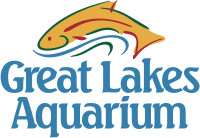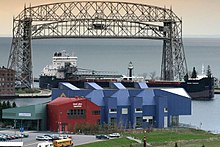The Arizona-Sonora Desert Museum is a 98-acre zoo, aquarium, botanical garden, natural history museum, publisher, and art gallery founded in 1952. Located just west of Tucson, Arizona, it features two miles (3.2 km) of walking paths traversing 21 acres of desert landscape. It is one of the most visited attractions in Southern Arizona.
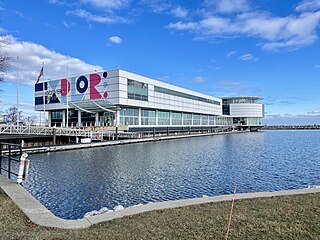
Discovery World is a science and technology museum in Milwaukee, Wisconsin.

Shedd Aquarium is an indoor public aquarium in Chicago. Opened on May 30, 1930, the 5 million US gal aquarium holds about 32,000 animals and is the third largest aquarium in the Western Hemisphere, after the Georgia Aquarium and Monterey Bay Aquarium.

The Seattle Aquarium is a public aquarium in Seattle, Washington, United States, located on Pier 59 on the Elliott Bay waterfront. The aquarium opened in 1977 and is accredited by the Association of Zoos and Aquariums (AZA).
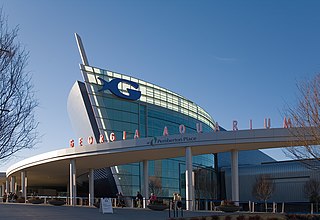
Georgia Aquarium is a public aquarium in Atlanta, Georgia, United States. The aquarium exhibits hundreds of species and thousands of animals across its seven major galleries, all of which reside in more than 11 million US gallons (42,000 m3) of water. It was the largest aquarium in the world from its opening in 2005 until 2012 when it was surpassed by the S.E.A. Aquarium in Singapore and the Chimelong Ocean Kingdom in China; the Georgia Aquarium remains the largest aquarium in the United States and the sixth largest in the world.
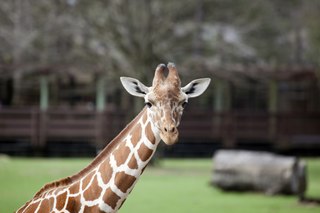
Montgomery Zoo is a 40-acre (16 ha) zoo located on the north side of Montgomery, Alabama. The zoo is an independent city department, and is supported in part by The Montgomery Area Zoological Society. It is home to approximately 750 animals representing 140 species. After not renewing their Association of Zoos and Aquariums membership in 2013, the zoo opted to remain accredited solely by the Zoological Association of America. The Mann Wildlife Learning Museum opened in January 2003 and serves as the administration building. The museum features taxidermy displays with a focus on native wildlife, game species, and wildlife management.

The Detroit Zoo is a zoo located in the cities of Huntington Woods and Royal Oak in the U.S. state of Michigan. Spanning 125 acres (50.6 ha), it houses more than 2,000 animals and more than 200 different species. The zoo was the first U.S. zoo to feature bar-less habitats, and is regarded to be an international leader in animal welfare, conservation and sustainability by the Detroit Zoological Society.
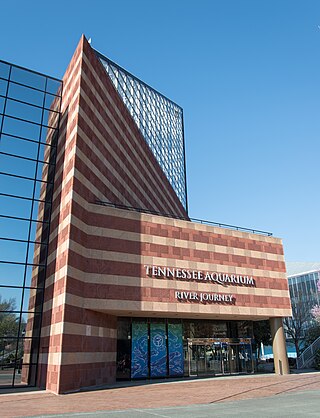
The Tennessee Aquarium is a non-profit public aquarium located in Chattanooga, Tennessee, United States. It opened in 1992 on the banks of the Tennessee River in downtown Chattanooga, with a major expansion added in 2005. The aquarium, which has been accredited by the Association of Zoos and Aquariums (AZA) since 1993, is home to more than 12,000 animals representing almost 800 species.
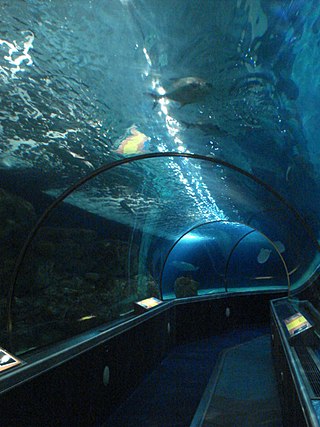
Sea Life at Mall of America is a public aquarium located in the Mall of America in Bloomington, Minnesota, United States. The 1.3 million-US-gallon aquarium contains thousands of aquatic creatures, including sea turtles, sharks, sawfish, stingrays, jellyfish and seahorses. There are eleven exhibits featured at the aquarium. The aquarium is highlighted by a 300-foot (91 m) 360° clear acrylic tunnel, which consists of four different areas housing both freshwater and salt water creatures.

The Maritime Aquarium at Norwalk is an aquarium located in the South Norwalk section of Norwalk, Connecticut.

The ABQ BioPark Aquarium, located in Albuquerque, New Mexico, United States is a facility of the Albuquerque Biological Park and is located next door to the ABQ BioPark Botanic Garden. The ABQ BioPark Aquarium exhibits Gulf of Mexico and South Pacific saltwater species from a variety of habitats, including surf zone, shallow waters, coral reefs, open ocean and deep ocean. The highlight of the aquarium is a 285,000 U.S. gal (1,080,000 L) shark tank with a 38-foot (12 m)-wide, 9-foot (2.7 m)-high, 8-inch (200 mm)-thick acrylic viewing window.

SEA LIFE Sydney Aquarium is a public aquarium in Sydney, Australia. Opened in 1988, it features a large variety of Australian aquatic life, displaying more than 700 species comprising more than 13,000 individual fish and other sea and water creatures from most of Australia's water habitats.

The Toledo Zoo & Aquarium, located in Toledo, Ohio is a member of the World Association of Zoos and Aquariums (WAZA), and is accredited by the Association of Zoos and Aquariums (AZA). The Toledo Zoo & Aquarium houses over 10,000 individual animals from 720 species and participates in around 80 species survival programs.
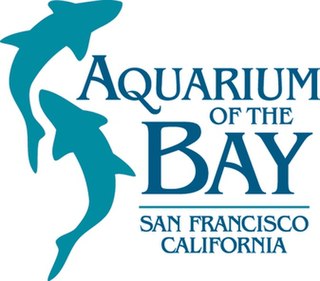
Aquarium of the Bay is a public aquarium located at The Embarcadero and Beach Street, at the edge of Pier 39 in San Francisco, California. The aquarium is focused on local aquatic animals from the San Francisco Bay and neighboring rivers and watersheds as far as the Sierra Mountains. Since 2005 the Aquarium has focused its mission on enabling ocean conservation and climate action both locally and globally. It is one of seven institutions under parent company Bay Ecotarium, the largest watershed conservation organization in the Bay Area

The Virginia Aquarium & Marine Science Center, formerly known as the Virginia Marine Science Museum, is an aquarium and marine science museum located in Virginia Beach, Virginia, just south of Rudee Inlet. The exhibits at the museum are contained in over 800,000 US gallons (3,028,000 L) of fresh and saltwater displays.

The Akron Zoo, officially known as the Akron Zoological Park, is a non-profit zoo located just west of downtown in Akron, Ohio, United States. The zoo sits on 77-acre (31 ha) of which 35-acre (14 ha) are occupied with by habitats, amenities, and support.
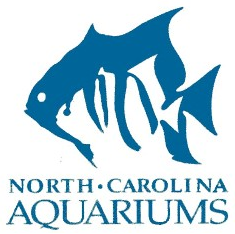
North Carolina Aquariums is a system of three public aquariums located in Kure Beach, Roanoke Island and Pine Knoll Shores. All are operated by the Aquariums Division of the North Carolina Department of Natural and Cultural Resources since 1976 and were accredited by the Association of Zoos and Aquariums. All three aquariums feature dive shows, live animal encounters, and feeding programs.
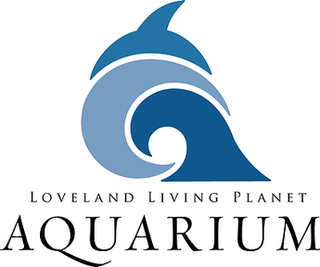
The Loveland Living Planet Aquarium is a public aquarium located in Draper, Utah, United States. It currently houses 4,500 animals representing 550 species, and it consists of five main exhibits.
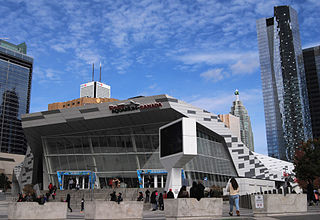
Ripley's Aquarium of Canada is a public aquarium in Toronto, Ontario, Canada. The aquarium is one of three aquariums owned-and-operated by Ripley Entertainment. It is located in downtown Toronto, just southeast of the CN Tower. The aquarium has 5.7 million litres of marine and freshwater habitats from across the world. The exhibits hold more than 20,000 exotic sea and freshwater specimens from more than 450 species.

The Aquarium of Niagara is a non-profit public aquarium in Niagara Falls, New York dedicated to education and conservation of aquatic life. Founded as a private company by a group of researchers and chemists as a test site for a groundbreaking formula for artificial seawater, the Aquarium opened as "The Aquarium of Niagara Falls" on June 12, 1965 as the first inland aquarium in the world to exclusively use this new technology to maintain thriving marine exhibits. Ownership was transferred to a non-profit foundation, the Sea Research Foundation, in September 1977, and then to the Niagara Aquarium Foundation on February 18, 1994. The aquarium is one organization featuring two buildings — the aquarium's historic Main Building, and Great Lakes 360, which opened in July 2024. The aquarium's Main Building features a wide array of aquatic species found in habitats around the world, including rescued seals and sea lions, Humboldt penguins, jellyfish, and colorful fish. Great Lakes 360 is home to 16 unique exhibits dedicated to the diverse habitats of the Great Lakes ecosystem, and features fish, reptiles, amphibians, and insects. The Aquarium of Niagara is accredited by the Association of Zoos and Aquariums, the Alliance for Marine Mammal Parks and Aquariums, and the International Marine Mammal Trainers Association.
